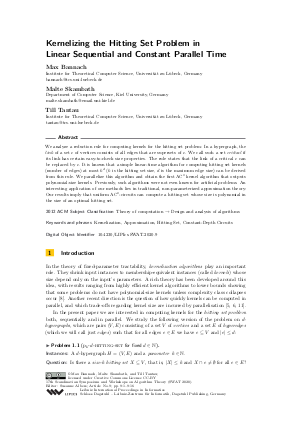Kernelizing the Hitting Set Problem in Linear Sequential and Constant Parallel Time
Authors Max Bannach, Malte Skambath, Till Tantau
-
Part of:
Volume:
17th Scandinavian Symposium and Workshops on Algorithm Theory (SWAT 2020)
Part of: Series: Leibniz International Proceedings in Informatics (LIPIcs)
Part of: Conference: Scandinavian Symposium and Workshops on Algorithm Theory (SWAT) - License:
 Creative Commons Attribution 3.0 Unported license
Creative Commons Attribution 3.0 Unported license
- Publication Date: 2020-06-12
File

PDF
LIPIcs.SWAT.2020.9.pdf
- Filesize: 0.55 MB
- 16 pages
Document Identifiers
Subject Classification
ACM Subject Classification
- Theory of computation → Design and analysis of algorithms
Keywords
- Kernelization
- Approximation
- Hitting Set
- Constant-Depth Circuits
Metrics
- Access Statistics
-
Total Accesses (updated on a weekly basis)
0PDF Downloads0Metadata Views
Abstract
We analyze a reduction rule for computing kernels for the hitting set problem: In a hypergraph, the link of a set c of vertices consists of all edges that are supersets of c. We call such a set critical if its link has certain easy-to-check size properties. The rule states that the link of a critical c can be replaced by c. It is known that a simple linear-time algorithm for computing hitting set kernels (number of edges) at most k^d (k is the hitting set size, d is the maximum edge size) can be derived from this rule. We parallelize this algorithm and obtain the first AC⁰ kernel algorithm that outputs polynomial-size kernels. Previously, such algorithms were not even known for artificial problems. An interesting application of our methods lies in traditional, non-parameterized approximation theory: Our results imply that uniform AC⁰-circuits can compute a hitting set whose size is polynomial in the size of an optimal hitting set.
Cite As Get BibTex
Max Bannach, Malte Skambath, and Till Tantau. Kernelizing the Hitting Set Problem in Linear Sequential and Constant Parallel Time. In 17th Scandinavian Symposium and Workshops on Algorithm Theory (SWAT 2020). Leibniz International Proceedings in Informatics (LIPIcs), Volume 162, pp. 9:1-9:16, Schloss Dagstuhl – Leibniz-Zentrum für Informatik (2020)
https://doi.org/10.4230/LIPIcs.SWAT.2020.9
BibTex
@InProceedings{bannach_et_al:LIPIcs.SWAT.2020.9,
author = {Bannach, Max and Skambath, Malte and Tantau, Till},
title = {{Kernelizing the Hitting Set Problem in Linear Sequential and Constant Parallel Time}},
booktitle = {17th Scandinavian Symposium and Workshops on Algorithm Theory (SWAT 2020)},
pages = {9:1--9:16},
series = {Leibniz International Proceedings in Informatics (LIPIcs)},
ISBN = {978-3-95977-150-4},
ISSN = {1868-8969},
year = {2020},
volume = {162},
editor = {Albers, Susanne},
publisher = {Schloss Dagstuhl -- Leibniz-Zentrum f{\"u}r Informatik},
address = {Dagstuhl, Germany},
URL = {https://drops.dagstuhl.de/entities/document/10.4230/LIPIcs.SWAT.2020.9},
URN = {urn:nbn:de:0030-drops-122566},
doi = {10.4230/LIPIcs.SWAT.2020.9},
annote = {Keywords: Kernelization, Approximation, Hitting Set, Constant-Depth Circuits}
}
Author Details
References
- F. Abu-Khzam, C. Bazgan, M. Chopin, and H. Fernau. Approximation algorithms inspired by kernelization methods. In ISAAC, 2014. URL: https://doi.org/10.1007/978-3-319-13075-0_38.
-
M. Ajtai. Approximate counting with uniform constant-depth circuits. In Advances In Computational Complexity Theory, 1990.

- N. Alon, R. Yuster, and U. Zwick. Color-coding. Journal of the ACM, 42(4), 1995. URL: https://doi.org/10.1145/210332.210337.
- M. Bannach, C. Stockhusen, and T. Tantau. Fast Parallel Fixed-parameter Algorithms via Color Coding. In IPEC, 2015. URL: https://doi.org/10.4230/LIPIcs.IPEC.2015.224.
- M. Bannach and T. Tantau. Computing Hitting Set Kernels By AC⁰-Circuits. In STACS, 2018. URL: https://doi.org/10.4230/LIPIcs.STACS.2018.9.
-
M. Bannach and T. Tantau. Computing Kernels in Parallel: Lower and Upper Bounds. In IPEC, 2018.

- D. Barrington, N. Immerman, and H. Straubing. On Uniformity within NC^1. In Structure in Complexity Theory, 1988. URL: https://doi.org/10.1109/SCT.1988.5262.
- H. Bodlaender, R. Downey, M. Fellows, and D. Hermelin. On problems without polynomial kernels. J. Comput. Syst. Sci., 75(8), 2009. URL: https://doi.org/10.1016/j.jcss.2009.04.001.
- L. Cai, J. Chen, R. Downey, and M. R. Fellows. Advice Classes of Parameterized Tractability. Annals of Pure and Applied Logic, 84(1), 1997. URL: https://doi.org/10.1016/S0168-0072(95)00020-8.
- M. Cesati and M. Di Ianni. Parameterized parallel complexity. In Euro-Par, 1998. URL: https://doi.org/10.1007/BFb0057945.
- Y. Chen, J. Flum, and X. Huang. Slicewise Definability in First-Order Logic with Bounded Quantifier Rank. In CSL, 2017. URL: https://doi.org/10.4230/LIPIcs.CSL.2017.19.
- P. Damaschke. Parameterized Enumeration, Transversals, and Imperfect Phylogeny Reconstruction. Theo. Comp. Science, 351(3), 2006. URL: https://doi.org/10.1016/j.tcs.2005.10.004.
- R. Downey and M. Fellows. Fixed-parameter tractability and completeness I: basic results. SIAM J. Comput., 24(4), 1995. URL: https://doi.org/10.1137/S0097539792228228.
- M. Elberfeld, C. Stockhusen, and T. Tantau. On the space and circuit complexity of parameterized problems: Classes and completeness. Algorithmica, 71(3), 2015. URL: https://doi.org/10.1007/s00453-014-9944-y.
-
P. Erdős and R. Rado. Intersection Theorems for Systems of Sets. Journal of the London Mathematical Society, 1(1), 1960.

- S. Fafianie and S. Kratsch. A shortcut to (sun)flowers: Kernels in logarithmic space or linear time. In MFCS, 2015. URL: https://doi.org/10.1007/978-3-662-48054-0_25.
- M. Fellows, A. Kulik, F. Rosamond, and H. Shachnai. Parameterized approximation via fidelity preserving transformations. J. Comput. Syst. Sci., 93, 2018. URL: https://doi.org/10.1016/j.jcss.2017.11.001.
- J. Flum and M. Grohe. Parameterized Complexity Theory. Springer, 2006. URL: https://doi.org/10.1007/3-540-29953-X.
- M. Furst, J. Saxe, and M. Sipser. Parity, circuits, and the polynomial-time hierarchy. Mathematical Systems Theory, 17(1), 1984. URL: https://doi.org/10.1007/BF01744431.
-
N. Immerman. Descriptive complexity. Graduate texts in computer science. Springer, 1999.

- D. Lokshtanov, F. Panolan, M. Ramanujan, and S. Saurabh. Lossy kernelization. In STOC, 2017. URL: https://doi.org/10.1145/3055399.3055456.
-
H. Moser. A problem kernelization for graph packing. In SOFSEM, volume 5404 of Lecture Notes in Computer Science, pages 401-412. Springer, 2009.

- I. Newman, P. Ragde, and A. Wigderson. Perfect hashing, graph entropy, and circuit complexity. In Structure in Complexity Theory, 1990. URL: https://doi.org/10.1109/SCT.1990.113958.
- R. van Bevern. Towards Optimal and Expressive Kernelization for d-Hitting Set. Algorithmica, 70(1), September 2014. URL: https://doi.org/10.1007/s00453-013-9774-3.
